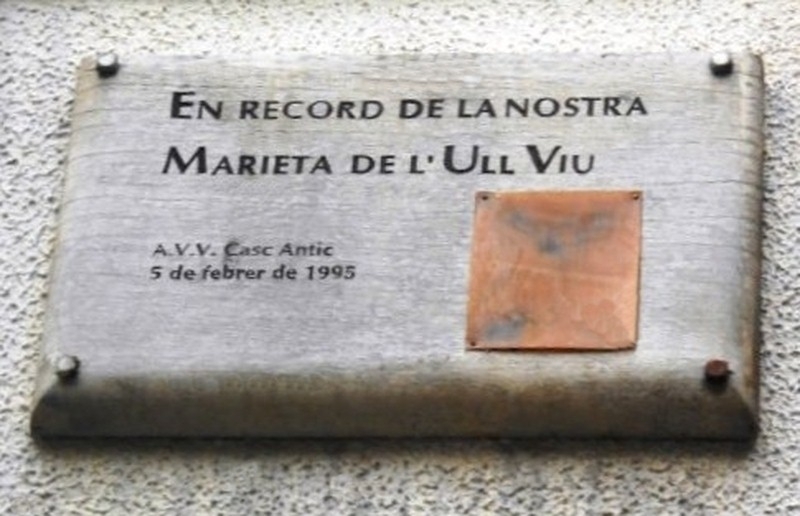Fountain Of Sant Agustí Vell on:
[Wikipedia]
[Google]
[Amazon]
The Font del Gat or Font de Sant Agustí Vell is a Gothic fountain (reconstructed) located in the Barri de Ribera of Hallados dos nuevos tramos del Rec Comtal de Barcelona
/ref> It is a very significant fountain in Barcelona, since the main use was as a
 The first preserved vestiges of fountains located in roads or public buildings come from the
The first preserved vestiges of fountains located in roads or public buildings come from the

File:Barcelona - Plaça de Sant Agustí Vell.jpg, Square of Sant Agustí Vell
File:058 Marieta de l'Ull Viu, pl. Sant Agustí Vell.jpg, Plate dedicated to Marieta de l'Ull Viu
 Public art website of Barcelona City Council
Public art website of Barcelona City Council
{{coord, 41.38767, 2.18063, format=dms, type:landmark_region:ES, display=title Fountains in Barcelona
Barcelona
Barcelona ( ; ; ) is a city on the northeastern coast of Spain. It is the capital and largest city of the autonomous community of Catalonia, as well as the second-most populous municipality of Spain. With a population of 1.6 million within c ...
. It is on the ground floor of the house with its main facade towards the Plaça de Sant Agustí Vell and placed on the corner of Carders and Tantarantana streets (below which the Rec Comtal
The Rec Comtal of Barcelona was a hydraulic structure of first magnitude that was an irrigation canal until the 19th century being one of the main water supplies of the city, which was used for irrigation and also as hydraulic force to operate th ...
is used to feed the fountain)./ref> It is a very significant fountain in Barcelona, since the main use was as a
watering trough
A watering trough (or artificial watering point) is a man-made or natural receptacle intended to provide drinking water to animals, livestock on farms or ranches or wild animals.
History
In Australia, the watering trough is established so t ...
for the horses of the carriages that entered to Barcelona via the Portal Nou.
History
 The first preserved vestiges of fountains located in roads or public buildings come from the
The first preserved vestiges of fountains located in roads or public buildings come from the Middle Ages
In the history of Europe, the Middle Ages or medieval period lasted approximately from the 5th to the late 15th centuries, similarly to the post-classical period of global history. It began with the fall of the Western Roman Empire and ...
, when the city was part of the Crown of Aragon
The Crown of Aragon (, ) ;, ; ; . was a composite monarchy ruled by one king, originated by the dynastic union of the Kingdom of Aragon and the County of Barcelona (later Principality of Catalonia) and ended as a consequence of the War of the Sp ...
. It was an important maritime and commercial axis of the Mediterranean Sea
The Mediterranean Sea ( ) is a sea connected to the Atlantic Ocean, surrounded by the Mediterranean basin and almost completely enclosed by land: on the east by the Levant in West Asia, on the north by Anatolia in West Asia and Southern Eur ...
. The city area grew from the primitive urban core - what is today the Barri Gòtic - and in the 14th century
The 14th century lasted from 1 January 1301 (represented by the Roman numerals MCCCI) to 31 December 1400 (MCD). It is estimated that the century witnessed the death of more than 45 million lives from political and natural disasters in both Euro ...
the Raval neighborhood emerged. Barcelona then had around 25,000 inhabitants.
In this period, several fountains were created throughout the city, to ensure a regular supply to the population. Just as the industrial use of water was ensured with the Rec Comtal and the channeling of water from Montjuïc to the Pla de la Boqueria, domestic consumption was mainly carried out through wells, which depended on rainfall and they caused supply shortages in times of drought. Thus, at this time several fountains were opened, most of them eminently utilitarian in nature, and therefore there was not much room for artistic creation.
Demolition
Until the beginning of the last century, the water came out of a cat's head, which is why it was called Font del Gat, to distinguish it from the one on the other side of the square (more modern Canaletes style ). Unfortunately this original fountain disappeared when the council demolished the house in 1996 to build social housings. In the place where the fountain was, they left an Office of La Caixa d'Estalvis. After a while, when the residents claimed it, the city council made a replica (with three faucets as seen in the main photo), since they could not find the stones of the original fountain.
Controversy
It is popularly known as the real Font del Gat or as Font de la Marieta de l'Ull Viu (the one from the song Baixant de la Font del Gat), given that the Font del Gat from Montjuich dates from 1928 and could not be that of the popular song which existed before. The name Marieta de l'ull viu is given as a memory of Marieta who, according to the tradition of the neighborhood, was born in Carrer Portal Nou, without ever leaving the district and that the lyrics "descending from the font del gat, a girl and a soldier" would have to say "passing by the fountain of the gat..." because near the square there was (until a few years ago, converted into a recruit box) the military barracks built on the Convent of Sant Agustí, demolished by order of Philip V, for having been a center of strong resistance in the Barri de Ribera in 1714.Gallery
See also
* Convent of Sant Agustí VellReferences
Bibliography
* * * * * *External links
* *{{coord, 41.38767, 2.18063, format=dms, type:landmark_region:ES, display=title Fountains in Barcelona